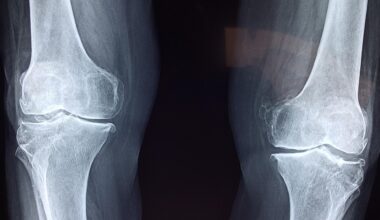Using Technology to Track Energy System Usage in Freerunning
Parkour and freerunning are dynamic sports that require proficient control over various energy systems. Athletes naturally utilize their anaerobic and aerobic systems during practice. Understanding this balance can significantly enhance performance. With the advent of technology, analyzing energy system usage has become easier, providing valuable insights into movement efficiency and effectiveness. By utilizing wearable technology, athletes and coaches can monitor heart rates, caloric burn, and even energy supply systems in real-time. This data informs training decisions, helping to prioritize specific energy pathways based on workout intensity. Moreover, tracking energy system usage allows for targeted conditioning, optimizing performance during competitions. Athletes can evaluate energy systems based on the specific requirements of various parkour maneuvers, tailoring their training accordingly. These insights can identify strengths and weaknesses, indicating where improvements can be made. The integration of apps and technology not only enhances performance but also increases safety by preventing overtraining and fatigue-related injuries, ensuring sustainable athletic development. Thus, the combination of technology with traditional training methods can lead to improved outcomes in freerunning, ultimately boosting skill and efficiency.
Understanding energy systems is crucial for freerunners. They employ anaerobic systems for short bursts of intense effort and aerobic systems for sustained activity. This dynamic interaction shapes their performance, necessitating tailored training regimens using technology. GPS trackers, heart rate monitors, and fitness wearables enhance this analysis. They capture data on how athletes utilize energy during parkour movements, facilitating a data-driven approach to training. Athletes can analyze performance metrics, comparing anaerobic and aerobic contributions during various exercises. This aids in optimizing workouts, focusing on either power or endurance based on daily training goals. Moreover, tracking recovery times is vital, as improper management can hinder progress. Understanding how energy is expended during parkour techniques helps identify fatigue points, allowing athletes to adjust routines accordingly. Technology ensures that no aspect of training goes overlooked. Utilizing apps that calculate energy expenditure provides athletes with clarity on their training impact. This precision enables better goal-setting and fosters improvements over time. Ongoing assessment through technology empowers athletes to adapt their strategies, ultimately resulting in a more refined and efficient approach to the sport as they seek to enhance their performance.
Wearable Technology in Training
Wearable technology has revolutionized training methods in parkour and freerunning, offering valuable insights into energy system usage. Devices like heart rate monitors and fitness trackers can provide athletes with real-time data. This data can indicate which energy systems are predominantly used during specific movements or stunts. With greater access to performance metrics, athletes can adjust their training plans for more effective outcomes. For instance, monitoring heart rate during high-intensity jumps informs athletes about their anaerobic capacity levels. Furthermore, understanding the energy spent helps in designing conditioning exercises that target both strength and endurance effectively. The ability to assess energy utilization can also lead to personalized training programs. Coaches can use collected data to adapt workouts based on individual athlete needs, ensuring that each session is maximally effective. The insights gained can fuel motivation, as athletes see progress unfold through data-backed improvements. Additionally, using technology enhances safety by revealing patterns of exertion that lead to fatigue. Athletes can make decisions to prevent injuries, ensuring longevity in their training and performance journey in the high-energy domains of freerunning.
Data analysis from wearable technology is enhancing performance evaluation in freerunning training. Athletes can now visualize their physical exertion levels across various workouts. By comparing this data, they can ascertain which exercises challenge their energy systems most effectively. Analyzing heart rate variability also aids in recognizing recovery needs, which is essential for sustaining high energy levels over time. Athletes can incorporate rest days when necessary, aligning their recovery schedules with collected data metrics. Additionally, technology empowers freerunners to experiment with new techniques, allowing them to monitor how each affects energy expenditure. If a particular movement leads to excessive energy loss, adjustments can be made to training habits. With ongoing analysis, the development of more effective strategies becomes undeniable, supporting overall athletic growth. Coaches also benefit from tracking athletes’ performances, realizing patterns that signify improvements or the need for intervention. Subsequently, tailored coaching can address arising issues and facilitate athlete development. As training evolves, athletes can refine techniques based on extensive data analysis, crafting an individualized path toward mastering the art of freerunning efficiently, sustainably, and safely, paving the way for incredible athletic performances.
Conclusion: Future of Technology in Freerunning
The integration of technology such as fitness trackers, apps, and data analysis software will continue shaping the future of parkour and freerunning training. As these tools evolve, the way athletes understand their bodies and movements will enhance, resulting in far more effective training strategies. The ability to monitor energy systems in real-time enables freerunners to adapt their techniques, focusing on personal development at a higher level than ever before. As athletes gain insights into energy expenditure, they can shift their training towards techniques that better fit their energy output. Furthermore, as more practitioners accept these advanced tools, a new culture around technology in parkour may emerge, fostering a community of data-driven athletes eager to optimize their training. Future advancements in technology will provide even deeper analytics into movements, possibly helping experts create comprehensive training methodologies. Acoustic sensors and motion detection could track energy use with unprecedented precision, allowing freerunners to achieve peak performance by maximizing their energy systems. Through such innovations, athletes will undoubtedly push their limits further, revolutionizing the sport while ensuring safe participation and injury mitigation.
The continuous quest for innovation in training will drive the development of new technologies tailored for freerunners. Emerging wearables equipped with AI-driven analytics may predict fatigue before it hampers performance. Thus, they will help athletes plan their training more wisely, enhancing the effectiveness of each session through tailored protocols. Such improvements promise to strengthen the relationship between energy system training and performance outcomes. Additionally, understanding metabolic pathways will inform coaching practices, ensuring every session’s design optimally develops the athlete’s body and skillset. Collaborations between technology developers and athletic training professionals will benefit practitioners at all levels, offering tools that suit both novice and experienced freerunners. As technology becomes more accessible, athletes will embrace these techniques, transforming their training environments into data-rich ecosystems. This shift towards science-backed training will enhance performance and bring a higher awareness of physical capabilities and limitations. Moreover, community engagement through platforms that aggregate data will foster interactions among freerunners, creating collaborative learning experiences. With innovation paving the way, parkour and freerunning may experience unprecedented growth, establishing themselves as exciting, popular sports backed by advanced technology and constant athlete adaptation.
Final Thoughts
As parkour and freerunning continue to evolve, effectively tracking energy system usage becomes crucial for athletes. Adapting training practices based on real-time feedback and data analysis will be essential in ensuring optimal performance in these demanding sports. The fusion of traditional training principles with modern technology not only enhances athlete effectiveness but also improves safety by acknowledging fatigue and recovery needs. As freerunners employ wearable technology to assess their energy systems, they will begin to recognize how to train smarter rather than harder. This fundamental shift in training philosophy has the potential to redefine performance benchmarks within the freerunning community. Engaging in data-driven training methodologies ensures sustainability, allows personal growth trajectories, and fosters an atmosphere of professional excellence. Furthermore, the wider integration of community-based tools will encourage athletes to learn from and support each other. By embracing technology as they pursue their craft, freerunners can document their journeys, share progress, and inspire future generations. Ultimately, by merging technological aspects with parkour philosophy, a balanced approach to training will pave the way for future successes in the athletic realm.
In conclusion, the use of technology in understanding energy systems opens new horizons for athletes engaged in parkour and freerunning. Monitoring performance through advanced analytics systems gives athletes opportunities to refine their approach, improve strength, and enhance endurance efficiently. Technologies, when effectively integrated into training, can enable athletes to unlock their full potential, cultivating a deeper understanding of their biomechanical needs. Therefore, as innovation progresses, it is the responsibility of each athlete to embrace these advancements and adapt them to their training philosophies. By fostering a culture of continuous innovation, the parkour community can collectively uplift the sport’s standards while ensuring that today’s athletes can compete at the highest levels safely. With wearable technology leading the charge, the future of parkour holds immense promise. By closely tracking energy systems, freerunners will gain insights that encourage optimal training practices for elite performance. This ongoing evolution signifies an exciting chapter in the world of freerunning, where athleticism meets technology, and every athlete can realize their fullest potential in captivating ways.


